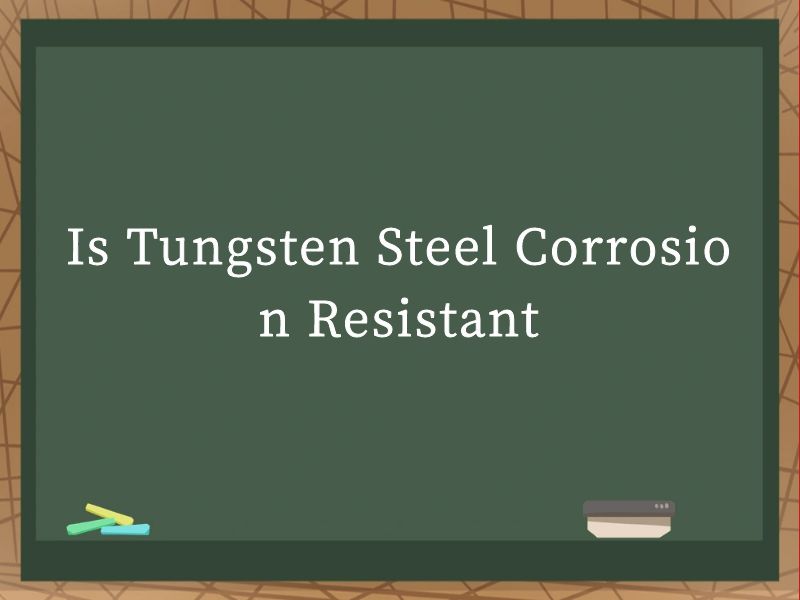JOURNALISM
- NEWS -
|
Is Tungsten Steel Corrosion Resistant?Is Tungsten Steel Corrosion Resistant?Tungsten steel, also known as tungsten carbide (WC), stands as a remarkable material in the realm of metallurgy and engineering due to its exceptional physical properties. Among these properties, corrosion resistance is a critical aspect that determines its applicability in various industries. Understanding whether tungsten steel is corrosion resistant involves delving into its composition, microstructure, and the mechanisms through which it interacts with corrosive environments.
Tungsten carbide is primarily composed of tungsten and carbon atoms, forming a hard, crystalline lattice structure. This structure gives tungsten carbide its exceptional hardness and wear resistance, making it suitable for applications that require high durability. The hardness of tungsten carbide far exceeds that of conventional steel, which is a crucial factor in its use in cutting tools, drills, and other wear-intensive components. Corrosion is a degradation process that involves the reaction of a material with its environment, typically leading to the loss of material properties and, ultimately, failure. In the case of metals and alloys, corrosion often involves the oxidation of the metal surface, forming oxides or other compounds that are less desirable for the application. To assess the corrosion resistance of tungsten steel, it's essential to consider the chemical stability of its constituents. Tungsten, a transition metal, is known for its high melting point and resistance to chemical attack. Carbon, in its covalently bonded form within tungsten carbide, further enhances the material's stability. However, corrosion resistance is not solely determined by the chemical stability of individual components but also by the material's microstructure and environmental conditions. One of the primary reasons tungsten carbide exhibits good corrosion resistance is its passivating behavior. In many environments, tungsten carbide forms a protective oxide layer on its surface. This oxide layer acts as a barrier, preventing further penetration of corrosive agents into the material's bulk. The formation of this oxide layer is similar to the passivation process observed in stainless steels, where chromium oxides create a protective film. However, it's important to note that the corrosion resistance of tungsten carbide can vary depending on the specific alloying elements and manufacturing processes used. Tungsten carbide is often produced as a composite material, where tungsten carbide particles are embedded in a cobalt matrix. Cobalt, while improving the toughness of the composite, can affect its corrosion resistance. In environments where cobalt is susceptible to corrosion, the overall performance of the tungsten carbide composite may degrade. Moreover, the microstructure of tungsten carbide can also play a role in its corrosion behavior. Porosity, cracks, and other defects in the material can provide pathways for corrosive agents to penetrate the surface and initiate corrosion. Proper processing and sintering techniques are crucial in minimizing these defects and enhancing the corrosion resistance of tungsten carbide. Environmental factors, such as temperature, pressure, and the presence of aggressive chemicals, also play a significant role in determining the corrosion resistance of tungsten carbide. High temperatures can accelerate corrosion processes, while aggressive chemicals may attack the material more readily. In such environments, additional protective measures, such as coatings or linings, may be required to ensure the long-term durability of tungsten carbide components. One of the industries where the corrosion resistance of tungsten carbide is particularly critical is the oil and gas industry. Drilling tools and equipment used in this industry are exposed to harsh conditions, including high temperatures, high pressures, and corrosive drilling fluids. Tungsten carbide-based tools, such as drill bits and cutters, are favored for their ability to maintain sharpness and durability in these environments. Similarly, in the aerospace industry, tungsten carbide is used in components that require high hardness and corrosion resistance. Turbine blades, engine nozzles, and other high-temperature components often incorporate tungsten carbide to ensure reliable performance under extreme conditions. Despite its impressive corrosion resistance, tungsten carbide is not immune to all forms of corrosion. In certain environments, particularly those with highly oxidizing agents or acids, tungsten carbide may experience accelerated corrosion. In these cases, the material's chemical stability can be compromised, leading to the degradation of its physical properties. To mitigate the risk of corrosion in tungsten carbide components, several strategies can be employed. Surface treatments, such as coatings or heat treatments, can enhance the material's corrosion resistance by modifying its surface chemistry and microstructure. Proper selection of materials and alloys, as well as careful design and manufacturing processes, can also contribute to improved corrosion performance. In addition to these strategies, regular inspection and maintenance of tungsten carbide components are essential in ensuring their long-term durability. Early detection of corrosion or other forms of degradation can allow for timely repairs or replacements, preventing costly failures and downtime. In conclusion, tungsten steel, or tungsten carbide, exhibits good corrosion resistance due to its chemical stability, passivating behavior, and protective oxide layer. However, its corrosion performance can be affected by various factors, including alloying elements, microstructure, and environmental conditions. Proper material selection, design, and maintenance are crucial in ensuring the reliable performance of tungsten carbide components in corrosive environments. When considering the corrosion resistance of tungsten carbide, it's also important to note that the material's hardness and wear resistance often make it a preferred choice in applications where corrosion is not the sole concern. In many cases, the combination of these properties allows tungsten carbide to outperform other materials, even in environments where corrosion is a significant issue. Research and development in the field of tungsten carbide continue to advance, with new alloys and manufacturing techniques being developed to enhance its corrosion resistance and other physical properties. As these innovations emerge, the applicability of tungsten carbide in various industries will likely expand, further solidifying its position as a key material in modern engineering and metallurgy. In summary, tungsten steel, or tungsten carbide, is a remarkable material known for its exceptional hardness and wear resistance. Its corrosion resistance, while good in many environments, can be affected by various factors. Proper understanding and management of these factors, combined with ongoing research and development, can ensure the continued success and applicability of tungsten carbide in a wide range of industries. By leveraging its unique properties and addressing its limitations, tungsten carbide will continue to play a critical role in advancing technology and innovation. |


